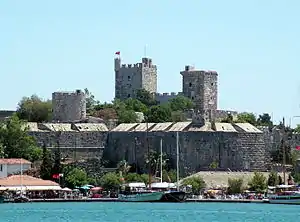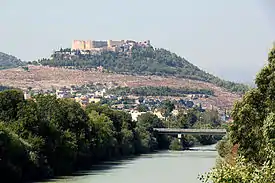Babakale Castle
Babakale Castle (Turkish: Babakale Kalesi, Ottoman Turkish: Hırzü’l-Bahr) is an 18th-century Ottoman era built fortification at Babakale, Ayvacık in Çanakkale Province, western Turkey.[1]
| Babakale Castle | |
|---|---|
Babakale Kalesi | |
| Cape Baba Near Babakale, Ayvacık, Çanakkale Province in Turkey | |
 Babakale Castle in 2015 after restoration | |
 Babakale Castle | |
| Coordinates | 39°28′45″N 26°03′51″E |
| Type | Castle |
| Site history | |
| Built | 1729 |


Babakale Castble is situated on a hill at Cape Baba, the westernmost location of Turkey, in Babakale, Ayvacık of Çanakkale Province. The castle takes its name from the cape. The castle was built to protect the location from pirates. It was constructed during the reign of Ottoman Sultan Ahmed III by Kapudan Pasha (Grand admiral) Kaymak Mustafa Pasha between AH 1135–1141 (1722–1729 CE).[1] The castle and the port next to it were also important for the anchorage and supply of the Ottoman Navy.[2] A fountain was added to catle, of which water was brought from 5 km (3.1 mi) away. The fountain supplied water for the naval fleet.[3]
There is a mosque in the castle. The castle hosted international festivals together with Lesbos in Greece in the years 1998, 1999 and 2000. Due to excavations carried out in 2001, no eventscould be held. It was suggested that the 27 houses, which were existed inside the castle in the past, would be rebuilt for tourism purposes on the foundation found in the excavation.[4]
References
- Acıoğlu, Yusuf (Fall 2015). "Çanakkale'deki Osmanlı Kaleleri". Çannakle Araştırmaları Türk Yıllığı (in Turkish). Academia. 13 (19): 93–122. Retrieved 1 February 2021.
- Açık, Deniz (17 August 2020). "Türkiye'nin asırlara meydan okuyan 'denize nazır' kaleleri". Anadolu News Agency (in Turkish). Retrieved 5 February 2021.
- "Babakale Kalesi" (in Turkish). Çanakkale. Retrieved 4 February 2021.
- "Osmanlı'nın son kalesinin içi tamir edilmeyi bekliyor Yunanistan ile ortaklaşa festivaller yapılan kalenin içi artık harabe". Habertürk (in Turkish). 20 June 2019. Retrieved 5 February 2021.

